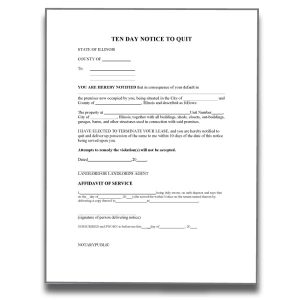Illinois Eviction Process
The information on this page summarizes residential evictions in Illinois and does not discuss commercial or agricultural real estate.
1. Write the termination notice. First, a landlord needs to write the appropriate preliminary notice to begin the Illinois eviction process:
- Illinois 5 Day Notice to Pay or Quit (For nonpayment of rent)
- Illinois 5 Day Notice to Quit (For serious unlawful activity/class x felonies)
- Illinois 10 Day Notice to Quit (For lease violations other than nonpayment)
- Illinois 30 Day Notice to Quit (For month-to-month agreements)
2. Serve the tenant and wait. A landlord must deliver the notice to the tenant and inform them of the violations. A landlord will then have the right to file for eviction after the notice period expires unless they offered the tenant a chance to correct the problem.
3. Summons and complaint is filed. If the tenant fails to cure the noncompliance or vacate, the landlord may begin eviction proceedings by filing a Summons & Complaint with a Local Circuit Court along with a copy of the required termination notice served on the tenant.
4. Tenant is served summons & complaint. The landlord must have copies of the court documents to give to the sheriff so they can deliver the summons and complaint to the tenant.
5. Eviction Order. If the tenant submits an answer, a court date will be scheduled to hear testimony from both sides. But if the tenant doesn’t respond, the landlord may request the court to issue an Eviction Order.
6. Sheriff’s Help. If the tenant is still living on the premises by this late stage, the landlord has the right to ask the sheriff to escort the tenant off the property.
Notice to Quit
A 5 Day Notice to Pay or Vacate demands a tenant to bring the rent current or vacate.
A 5 Day Notice to Quit may be used if a landlord wants to either allow a tenant to become compliant or just terminate the lease.
A 10 Day Notice to Quit is for any other violation of tenancy besides delinquent rent.


